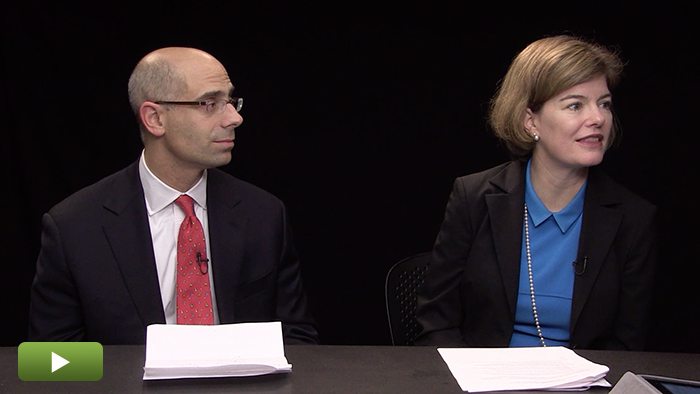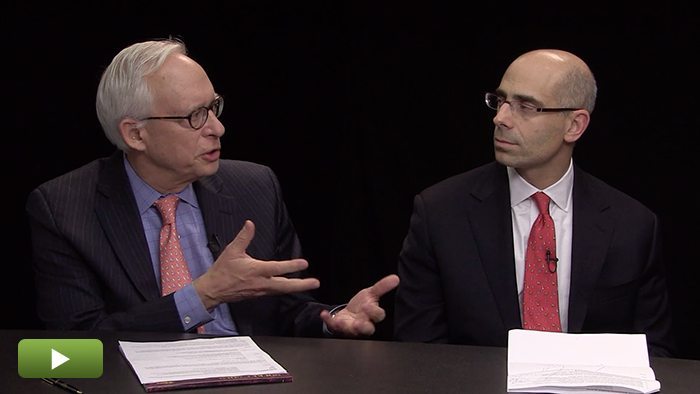Turning PE Liquid
Privcap
We’re talking about a term we’re hearing more about recently—liquid alternatives. All three of you approach this growing field from a different perspective. Kevin, can you talk about what you’re working on?
Albert
The decline of defined benefit plans is unquestionable in the corporate market and looks to be starting to happen in the public plan market globally. That has implications for private equity’s ability to fund itself going forward and all of us are looking at different markets: listed, open-end, defined contribution, high-net worth investors. Those categories of investors have different needs and preferences. That’s going to give rise to an amazing amount of innovation.
Privcap
Paul, can you talk about your program and where liquid alternatives come in?
Weisenfeld
I’m responsible for the distribution of mutual funds and ETFs at Morgan Stanley. We make available about 5,000 mutual funds and about 1,000 or 1,100 ETFs. One of the biggest areas today is liquid alternatives. That’s public mutual funds and even ETFs. We evaluate five to 10 different open-end mutual funds in the liquid alternative space at any given time, and we talk to at least one asset manager every other day about liquid alternatives. It’s a common topic.
Albert
Paul, when you use the term liquid alternatives, do you include private equity and brick and mortar real estate?
Weisenfeld
Many of us are beholden to what Morningstar would categorize as liquid alternatives. Even Morningstar would tell you it’s changing on a regular basis.
Privcap
Paul, why are you getting more inquiries about liquid alternatives? Do people know what it means?
Weisenfeld
More and more, advisors and clients understand what it is. At our firm, about two-thirds of our financial advisors are trained in alternative investments. We have an interest in that space because, historically, the lion’s share of our clients participating in alternatives did so with private products. The number of liquid alternatives has increased in the last several years and so has the flow into the space.
Privcap
Is it the liquidity driving demand, or the features of the underlying asset class that the advisors see as being beneficial to the portfolios of their clients?
Weisenfeld
Both apply. The appeal of liquid alternatives is you have to plan less, and you’re more flexible. There’s no question the greater availability of daily liquid mutual funds has also driven demand. From an advisor’s perspective, there’s a big difference.
Privcap
Suzanne, it sounds like there’s a need for innovation given the changing appetites of investors who haven’t participated in investment classes like this. Is that what’s driving the change?
Donohoe
At the core, what’s driving this change is the low-rate environment we’re operating in, and a sense that’s not going to persist forever. People need more return to provide for their retirement. On the demand side, people have gotten more open minded about the sources of return for their portfolios. On the supply side, you have more managers who’ve tried to find a way to meet the liquidity parameters of a 40 Act mutual fund.
Weisenfeld
There’s a disconnect between the product proliferation and demand. We’ve seen a tremendous amount of flows into the long/short fixed-income mutual fund space, which lends itself to daily liquid products.
Privcap
We’re largely talking about 40 Act mutual funds. Suzanne, can you define that term and talk about, for KKR, what kinds of underlying activities and assets are in the first batch of products created?
Donohoe
When people refer to the 40 Act, they’re typically thinking of the 1940 Act rules, which effectively created a registration framework for the sale of products to all types of investors. There are some structural limitations on what’s permitted as the underlier in a 40 Act format.
Weisenfeld
We’ve seen those products for some time. What it will take to make those strategies successful is for someone to prove there is an illiquidity premium in returns.
Albert
The question is whether there’s inherently a premium for liquidity, or is there only a premium for being a patient investor and staying while the magic is happening at the company level?
Weisenfeld
It’s a great question. If I were a portfolio manager and didn’t have to worry about being liquid every day, I’d be more patient as an investor. There’s clearly an opportunity for an illiquidity premium, and one of our challenges is educating financial advisors and clients about what it is.
Privcap
Liquid alternatives take underlying assets that haven’t traditionally been made available to certain investors and make them available. Paul, what are the challenges in taking illiquid investment classes like private equity and putting them in a liquid format?
Weisenfeld
What makes people anxious is a mismatch between liquidity of the underlying investments and the vehicle itself. If clients are requesting that their money come back and the fund sponsor can’t deliver, there are problems. There are regulatory requirements on how much can be liquid, but an investor doesn’t want to risk not getting their money back.
Privcap
Kevin, why is there not yet a private equity mutual fund?
Albert
They’re illiquid investments that haven’t been valued on a frequent basis, so there’s no fair value to enable them to change hands. The innovation that will allow more liquidity in private equity for the investor is more frequent daily valuations. Algorithms have been developed, extensively tested, proven to be accurate, and applied to existing portfolios. It will require working with regulators to relieve some restrictions on the use of mutual fund vehicles to deliver private equity to individuals. It all comes back to the ability to create a daily fair value.
Weisenfeld
It’s one thing to make a product available that can create liquidity, and an institutional or sophisticated investor can understand its complexity. The challenge of the 40 Act structure is that it’s available to all investors, and it’s important they understand the vehicle’s complexity.
Privcap
Kevin, can you give more detail about how daily liquidity would be achieved, who would provide that, and what the hurdles are?
Albert
Through the use of the PE secondary market, it’s possible to create a liquid vehicle that can be traded daily on the New York Stock Exchange at or above net asset value. Many of these vehicles have been tried in Europe, but they tend to not be structured with good governance or pay a dividend, which has been a successful indicator of a closed-end fund vehicle trading at a premium in the U.S. That’s going to be the daily liquidity.
Privcap
Haven’t variations of these types of products been tried in prior cycles?
Weisenfeld
We’ve seen a variety of products. Seven, eight, nine years ago, we saw a number of 130-30 funds [go long 130 percent, short up to 30 percent]. That was an area we heard a lot about for 18 months, and it never gathered a tremendous amount of assets.
Privcap
There was a demand problem?
Donohoe
A lot of it had to do with the environment. The 130-30 products were coming at a time when the equity market was running hard and people had the choice between hedged equity exposure or full exposure. It was more complexity than they had appetite for.
Weisenfeld
Investment performance was a big issue. If you can’t deliver what clients want, they won’t buy it. The shift toward defined-contribution plans having daily liquidity is the appeal.
Donohoe
There will be innovation as managers figure out ways to diversify. It will be most successful for managers who can bring their highest-octane strategy and not have to change it much to deliver a return for clients.
Albert
Five or 10 years ago, managers could raise all of their capital in the traditional market and weren’t looking at alternatives. Valuation technology, and being able to strike accurate daily valuations, is going to make a difference in the ability to do this in a high-quality way.
Transforming private equity into a more liquid asset class is a challenging task, say panelists from Pantheon, KKR, and Morgan Stanley. However, innovations and moves to address vehicle complexity are expected to help.




